Climbing The Marangu Route - Kilimanjaro Summit
This page describes the last two days of a Kilimanjaro climb on the Marangu route, the Kilimanjaro summit attempt.
A detailed description of days 1-3 of climbing Marangu is here:
Climbing Kilimanjaro on the Marangu Route
Rongai climbers use the same summit path. A description of days 1-4 of the Rongai route is here:
Climbing Kilimanjaro on the Rongai route
Kilimanjaro Climb on the Marangu Route - Day 4
(= Day 5 of the Rongai route)
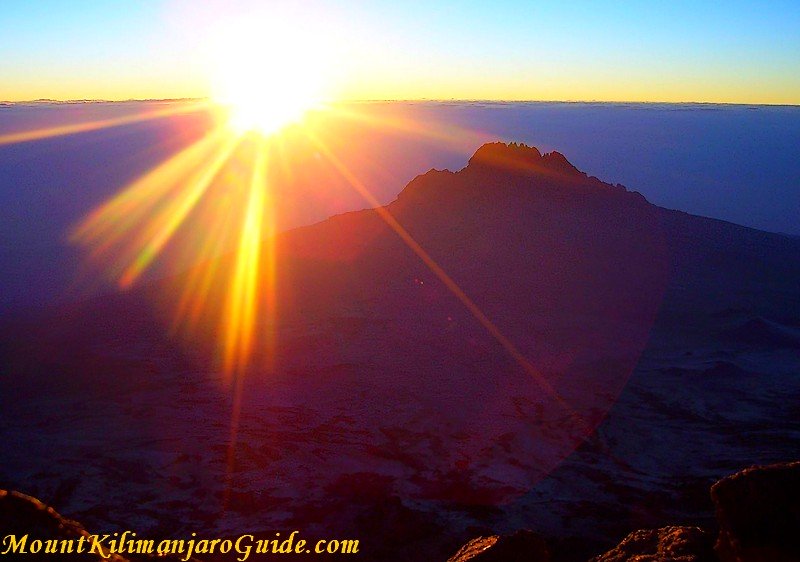 Sunrise viewed from the crater rim of Kilimanjaro (Marangu Route, Gilman's Point)
Sunrise viewed from the crater rim of Kilimanjaro (Marangu Route, Gilman's Point)
I hope you arrived at Kibo Huts early enough to get plenty of rest. (Rongai route climbers will have, Marangu route climbers may not.)
Your day pack should be ready with everything you will need tonight: rain gear if you aren't wearing it anyway, enough water, hand warmers, balaclava... You should have fresh batteries in your head torch and camera and you should already be wearing the right clothes. Make sure everything you are wearing is bone dry!
This day will likely go down in your memory as the most physically challenging day in your whole life. Likely it will also be one of the earliest starts you ever made...
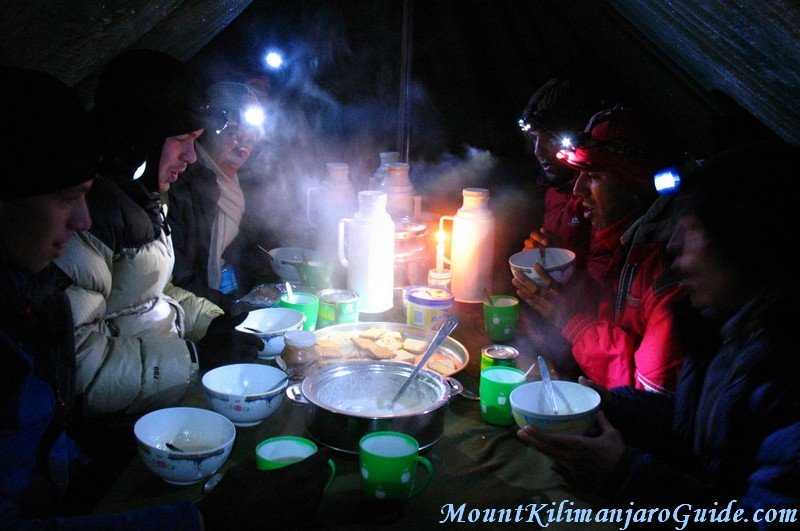 A chilly breakfast on summit day.
A chilly breakfast on summit day.
Your guides will wake you up some time
between 11.00 and 11.30 pm. There will be some hot drinks and maybe some
food, but mostly it's a matter of crawling out of your sleeping bag,
putting on a few more layers of clothes, your boots and your head torch.
Grab your day pack and off you go... Around midnight or not long after.
As you emerge from between the Kibo Huts you will see strings of little lights. They are the head torches of the climbers ahead of you, and as you continue through the night they will also appear behind you.
All those groups of little lights are moving in slow motion, following the path snaking back and forth, back and forth, up the steep scree slope that is the side of Kibo Peak. It's actually rather pretty. Whether you'll be able to appreciate it is a different question.
As steep as the slope is, due to the many switchbacks the path itself isn't all that bad. However, nothing's easy without oxygen and the air is incredibly thin, getting thinner all the time.
You may feel horrible and the fact that this is supposedly the easier path to the Kilimanjaro crater rim will offer little consolation.
Take all the time you need and for goodness sake don't let anyone pressure you into moving faster than you feel comfortable to. Steady, steady, one tiny little step after the other.
Other groups overtaking you? Let them go!
It doesn't matter if you reach Uhuru Peak or even the rim in time for sunrise. It only matters that you reach it and that you will be able to get back down safely! You can not move too slowly on Kilimanjaro.
The people who do not feel the effects of the altitude are few and far between. Hopefully the worst you have to deal with is a headache and the occasional wave of nausea. Throwing up is not as uncommon as you might hope and is no reason for concern. It's only awful.
There are several landmarks that you will likely use as resting points and that break up the slog:
Williams Point (you'll notice a big rock, or maybe you won't notice...) marks the 5000 m line (16400 ft). The Hans Meyer Cave lies at 5150 m (16900 ft), about two and a half hours from Kibo Huts.
It's impossible to have long breaks in these temperatures. The cold starts creeping into your hands and feet first, then into your whole body. The next section of switchbacks is the most exposed, and if it happens to be a windy night you'll feel it badly.
Another
one and a half hours after leaving the cave you start noticing rocks on
the path, breaking your steady rhythm and requiring bigger steps. Some
are also a bit slippery and you have to watch your step. The area is
called the Jamaican Rocks. (There are several stories as to why.)
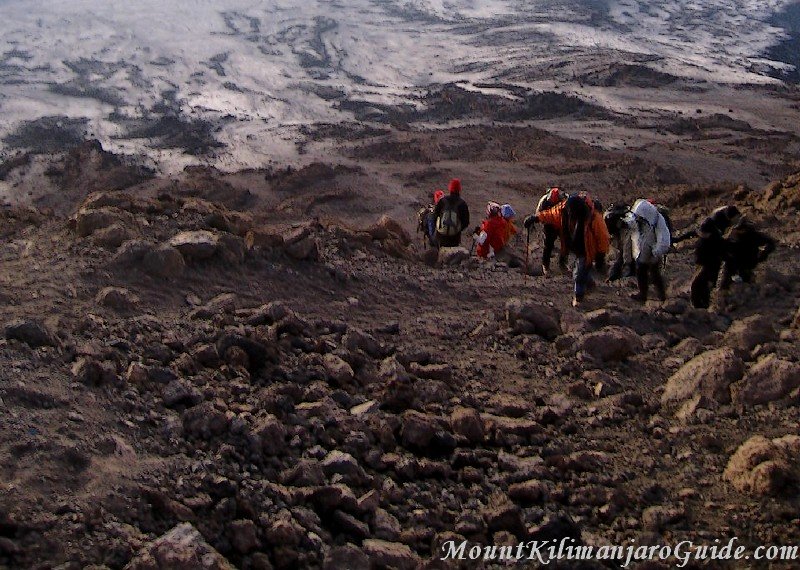 Climbers and guides on the last metres to the Kilimanjaro crater rim.
Climbers and guides on the last metres to the Kilimanjaro crater rim.
This is the most difficult part of the climb, but take heart, Gilman's Point is not far now! It will take about another hour.
If you are among the slower climbers, don't worry. The break of dawn invariably provides a much needed boost of energy for those last metres, and before you know a sign will be welcoming you to Gilman's Point, at 5681 m/18640 ft. At least that's what the sign says. It is actually a bit higher than that. Anyway...
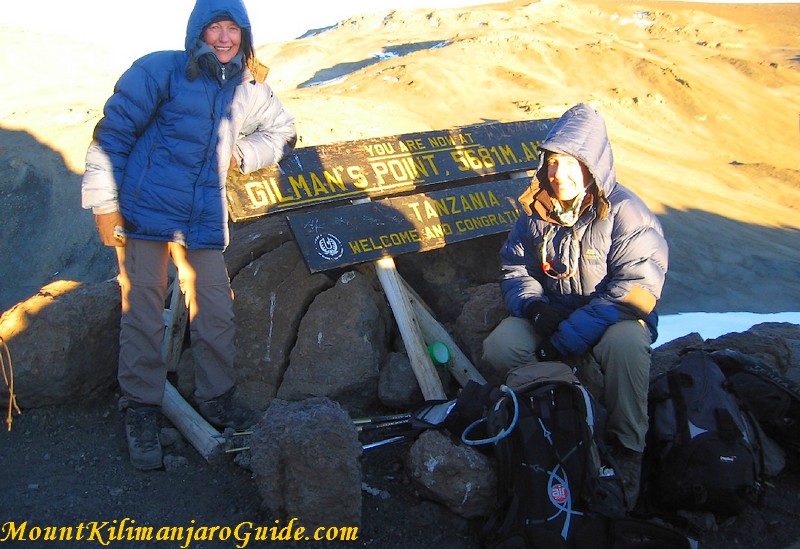 Climbing the Marangu route you reach the Kilimanjaro crater rim at Gilman's Point.
Climbing the Marangu route you reach the Kilimanjaro crater rim at Gilman's Point.
Congratulations to you, for you have done well!!
The park authorities will reward you with a certificate, even if you decide not to continue along the crater rim past the glaciers to Uhuru Peak.
If you want to continue, it's another hour and a half or so along the crater rim to reach Uhuru Peak. And even though most consider the climb up to Gilman's the hardest part, the walk around the rim can prove challenging, too.
The more time you spend at this extreme altitude, the more you will feel it. Uhuru Peak is another 200 m higher, and believe me, 200 m make a difference at this height.
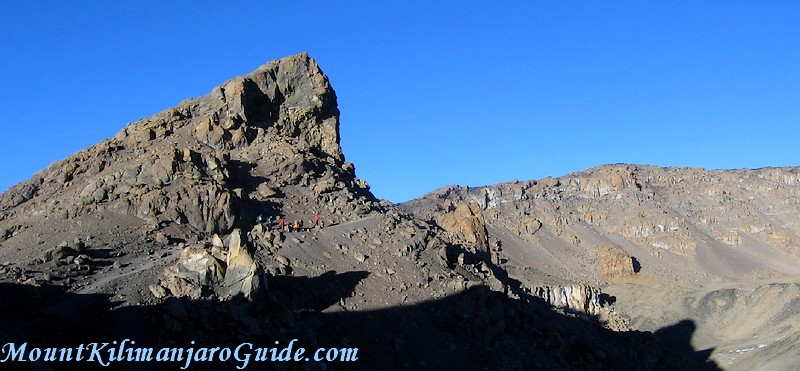 Climbers on the Kilimanjaro crater rim path between Gilman's Point and Stella Point.
Climbers on the Kilimanjaro crater rim path between Gilman's Point and Stella Point.
The first part of the rim walk is the easier part, but once you pass Stella Point the path leads uphill again. (Stella Point is at 5752 m/18171 ft and is the point where the other climb routes reach the rim.) The path may not look steep, but by now every step uphill can be a battle...
To get to Uhuru Peak and back allow another three hours that may turn out tougher than you expected.
(Mind you, for other people it's a breeze, but it's certainly better to be prepared for the worst and find it easier than expected, than the other way around.)
Congratulations again. What you just accomplished is truly impressive and no matter what you expected, the reality of it will be totally different. Some people get very emotional, some are on a big high, some are so dazed, they barely take any notice at all... There is no way to describe or imagine the experience of climbing to nearly 6000 m altitude.
It's time for hugs and photos. There won't be time for much else, because it will be too cold and also too dangerous to remain at this altitude for more than a few minutes.
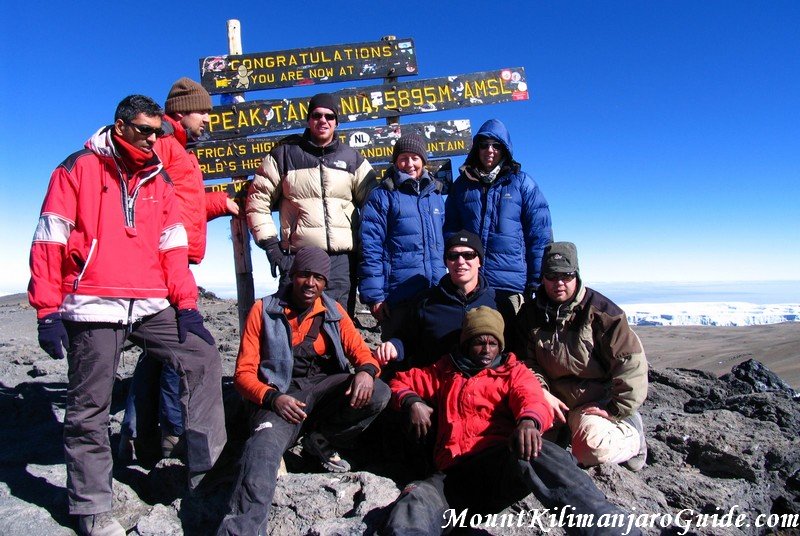 The summit of Kilimanjaro, Uhuru Peak.
The summit of Kilimanjaro, Uhuru Peak.
You probably don't have the tiniest little bit of energy left now. Well, guess what? The day has only begun and it's another long day...
You now have to drag yourself back to Gilman's Point. From there it's nearly 1000 m down, down, down... Until you get back to Kibo Huts. The descent is cruel on the knees and you will appreciate the walking poles!
If you scree run then this isn't too bad. It's actually quite fun. And fast! But pity those who have to stagger back down the same way they came up, switchback for painful switchback...
Lunch should be waiting for you at Kibo Huts. You just want to collapse and sleep; you can not imagine getting up from that chair again. But after what you have done to your body today it is not safe to remain at this altitude. You have no choice but to pack up your gear and keep going, the sooner the better. Three more hours to the Horombo Huts...
What will happen now is something of a miracle. Because as you descend further there will be air again. Oxygen! Lots of it!
Oxygen is life and that is exactly what will be injected back into you. You may not believe this now, but there is a good chance that after another three hour descent you may feel better and have more energy than you did at lunch time.
Dinner is often a much livelier affair, with everybody's eyes shining as they recount the experiences of the day. And I have no doubt that you will sleep well tonight!
Kilimanjaro Climb on the Marangu Route - Day 5
(= Day 6 of the Rongai route)
It's your last day on the mountain and there isn't much to say about it.
After beakfast you set off, down, down, down, past Mandara Huts (lunch stop) to Marangu Gate. If you climbed on the Marangu route you already know the path.
If you came up via the Rongai route then it's new territory and you will enjoy the last day in the lush rainforest. (Though some climbers can muster only a very moderate interest...)
Once you get to the gate you'll have to endure some more formalities, but eventually you will say good bye to your guides (a sad and emotional moment), climb into the vehicle waiting for you and be whisked away to your hotel for hot showers and cold beers.
Climbing Kilimanjaro on the Marangu Route, Day 1 - 3
Pictures of the Marangu Route
Climbing Kilimanjaro on the Rongai Route, Day 1 - 4
Photos of the Rongai Route
More about All Kilimanjaro routes
Do you need help with all this?
Would you like to contact a responsible and trustworthy tour operator with competitive prices?
Get some free, no obligations advice on route selection, duration and timing?
I regularly receive emails asking me if there is a tour operator I personally can recommend.
There is and you can contact my preferred operator through this page.